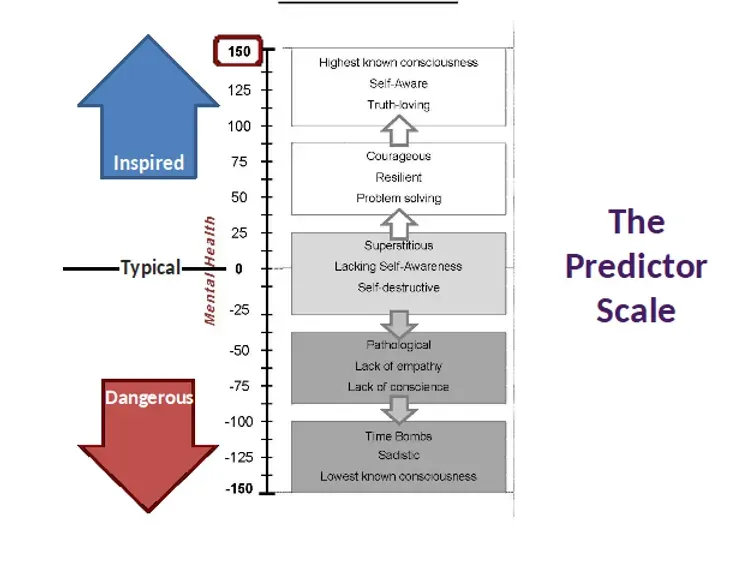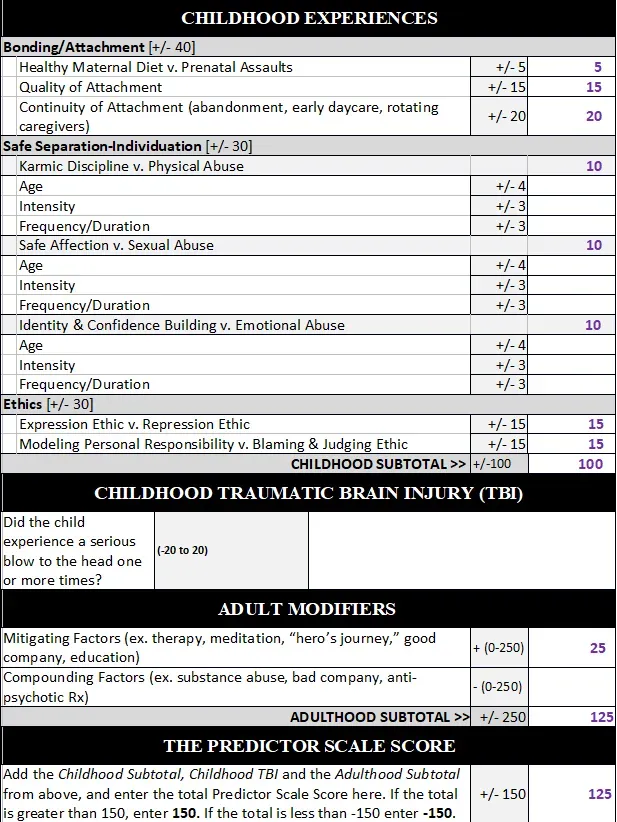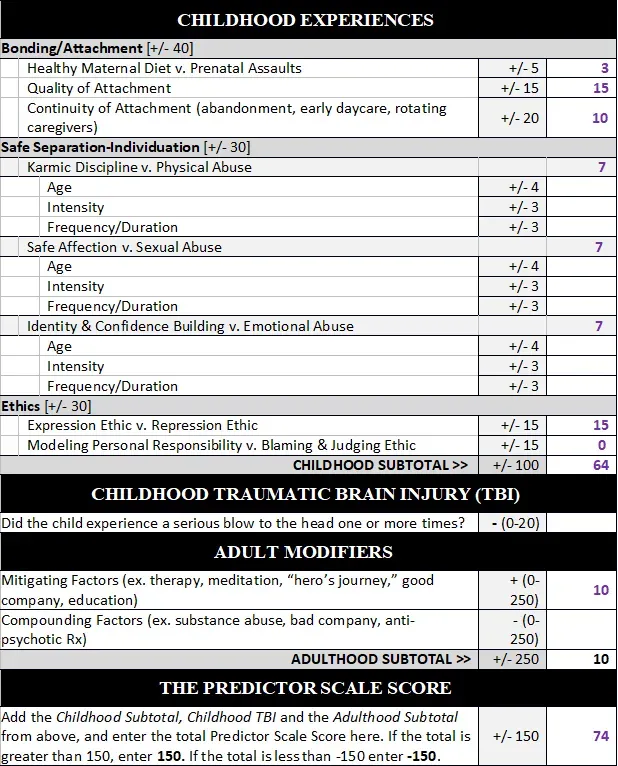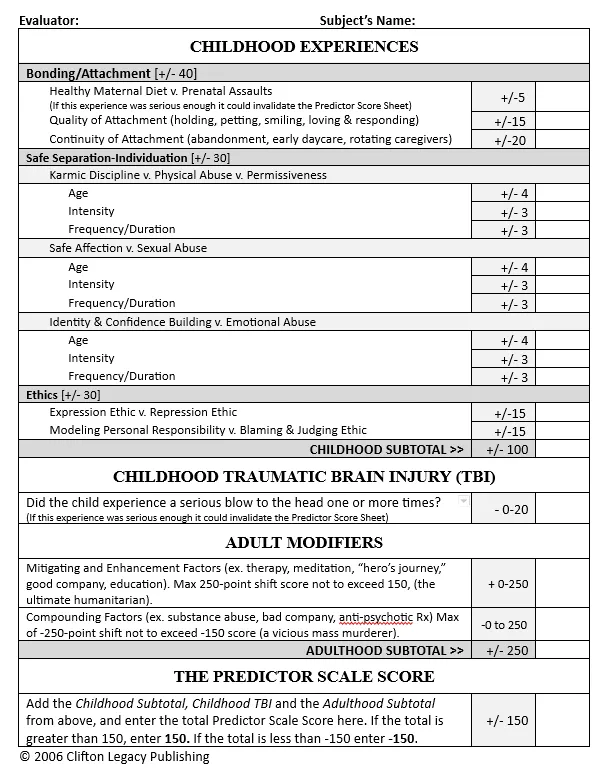The Parc Foundation
THE PREDICTOR SCALE
A guide to evidence based evaluations of formative experiences and personality development
Home > About Us
What is THE PREDICTOR SCALE?
The Predictor Scale ranges from -150 to 150, where scoring is determined by formative experiences and modifiers from adult life. Scores suggest the likelihood of the scored individual to engage in certain types of behavior. A low score will indicate a likelihood for harmful or violent behavior and a high score indicating a likelihood of exemplary behavior as well as a high resilience to trauma.

WHAT IS THE PREDICTOR SCALE?
View Dr. Faye's full synopsis of the predictor scale here
The Predictor Scale ranges from -150 to 150, where scoring is determined by formative experiences and modifiers from adult life. Scores suggest the likelihood of the scored individual to engage in certain types of behavior. A low score will indicate a likelihood for harmful or violent behavior and a high score indicating a likelihood of exemplary behavior as well as a high resilience to trauma.
This scale is not a tool for predicting specific behaviors, and is not predictive of personality disorders. The closest we get to such specificity comes from understanding mirror neurons, and the idea that people incorporate into their arsenal of responses that which they witnessed and experienced in early childhood.
The Predictor Scale should be scored by people who understand mirror neurons and imprinting, but these specifics are not what we need to know to raise a child or to understand a person. The Predictor Scale offers what we need to determine whether a child is headed for a fulfilling life or major harm, whatever the provocation or inspiration.
Why the predictor Scale is important
One may notice the rise in violent behaviors amongst young adults and journalists who report that psychologists don’t know why all the shootings are increasing. Instead of educating the public in prevention, we have been accepting the pharmaceutical solutions.
The Predictor Scale and Score Sheet was inspired by very bad forensic evaluations that appear biased and vary irrationally from one expert to another, operating on hunches, producing different explanations and predictions, as “experts” fail to consider all the critical factors that influence behaviors and insight. The Scale and Score Sheet was especially inspired by meeting so many educated and well-intentioned parents who made harmful choices out of ignorance. The failure to understand the necessity of taking together the information from all major studies of behaviors has left us blind and ignorant.
The primary purpose of The Predictor Scale is to educate all the offshoots of research in the field about the quality results of the other scientists in other lanes, so that the interpretations of their own work consider other valid explanations as well as interrelatedness.
Why the predictor Scale is important
Scored Examples
Below are three example individuals scored on the predictor scale.
Warning! Some of the information in this section contains descriptions of violence and child abuse.
Malala Yousafzai, a Hero
Malala’s father loved teaching and was a teacher. When his daughter was born, he did not despair that she was a boy, but named her after a famous Pakistani legend who championed women and was known as “a girl from paradise” and a “grief stricken” savior. Malala’s mother was a loving, shy stay-at-home mother raised chickens for their eggs and cooked from their vegetable garden.
Malala’s father spent their nights educating Malala and his younger children. He and Malala decided to open a school for girls and Malala rode in their little school bus to pick up the other girls to go to school, which was against strict Muslim principles.
One day some armed Taliban soldiers boarded the school bus and asked, “Who is Malala?” After a moment of silence, Malala, knowing she could be shot, responded, “I am Malala.” She was shot twice in the head, but was airlifted to Great Britain, where her life was saved, although her face was scared. She continues as an activist to support education for girls, and she won the Nobel Peace Prize in 2017.

Amanda Knox, The Foreign Exchange Student
Amanda Knox was an American exchange student convicted in 2009 of the murder of her new roommate Meredith Kercher in Perugia, Italy, where she was continuing her education in foreign languages and creative writing. She served four years of a 26-year sentence, before the verdict was reversed. In September 2013, the courts reopened her case, and a retrial began in absentia.
manda Knox was raised in a normal middle-class environment. Her mother was a math teacher, and her father was a businessman. Her parents divorced when she was about three years old. She visited her father, step-mother and three younger half-sisters two weekends monthly. Her parents cooperated in sharing custody.
When Amanda was about eight, her mother reportedly became involved with a younger man, 16 years her junior, which reportedly embarrassed Amanda. Nevertheless, Amanda was close to her mother and the rest of her family.
Amanda was an active child who loved sports and excelled in soccer, earning the nickname “Foxy Knoxy” for her clever defensive moves. She enjoyed play and she enjoyed work too. She loved school and made good grades. She chose a religious college for her undergraduate studies. She was apparently not very interested in boys during high school and college and focused primarily on her academic studies. She studied hard. She wanted to become a linguist and travel. She learned three other languages in college and supplemented her studies by reading literature in foreign languages. She wrote short stories and poetry, some dealing with violent plots. She worked several part-time jobs to save money so she could go to college abroad.
Shortly before she left for Europe, Amanda began to break out into partying, dating, and having sex. She had sex with seven different young men before she was arrested for murdering her roommate in Italy.
Shortly before beginning her education in Italy, Amanda became roommates with a young woman from England. They were compatible but did not know one other well. One night her roommate was murdered while Amanda reportedly spent the night with a young man she really liked, perhaps even loved. They smoked some marijuana and had sex. She came home to shower, encountered suspicious circumstances, and called her mom while her new beau called the police.
Amanda and her new boyfriend made a bad impression on observers. She did not seem distraught over the murder but was seen hanging onto her new boyfriend as they waited for the police to finish at her apartment. While he was being interrogated, she waited for hours in the lobby, biding her time doing yoga headstands (which the press reported as cartwheels). She claims she struck during her extended five-day interrogation and that she was pressured into a false confession.
Both were arrested and charged. The police and prosecutors helped the press build a case that Amanda was a sociopath before the forensic evidence was evaluated. The DNA from the scene did not support the couple as murderers but led to another party who pled guilty and claimed that Amanda was not a part of the crime. Nevertheless, the couple was tried and found guilty for aiding in the crime. A higher court released her after four years. She is to be tried again if she returns to Italy. Except for her vague confession under reported duress, she has continuously claimed her innocence and even wrote a book, Waiting to Be Heard.

Robert Alton Harris, a Killer
Robert Alton Harris was executed in 1992 for the murder of two teenage boys. He was charged with special circumstances for the coldness of the crime.
Robert Alton Harris was the middle child of nine children. His father, Kenneth, had been awarded the Silver Star and Purple Heart in World War II. Harris’s mother, Evelyn, was a Native American who supported the family as a migrant worker, when her husband was gone. Both his parents were alcoholics and Harris reportedly suffered from fetal alcohol syndrome. His father didn’t believe Harris was his son and hated the baby before he was born. He kicked his wife in the belly numerous times while she was pregnant with him, forcing her to deliver two months early. Harris’s mother ignored her baby after he was born to avoid beatings.
When Harris was a boy, his father took him to the desert with a gun, told him to start running, and began shooting at him, just missing him slightly to the right and slightly to the left, again and again.
Harris’s father was sentenced to prison twice for molesting his sisters, the first time for 18 months, and the second time longer. He beat his wife and children, but especially targeted Robert, who was frequently beat about the head. Young Harris began having run-ins with the law at age 10 and was sentenced to a reformatory at age 13 for stealing a car. At 14 his mother abandoned him.
Harris ultimately found work, married and had a child before he was sentenced for manslaughter and paroled in 1978, the year he invited his younger brother along for a robbery that became a cold-blooded killing.
At age twenty-five Harris borrowed a gun from his parents’ home and asked his younger brother, Daniel, if he wanted to help him rob a bank. They commandeered a car from two 16-year-old boys and had them drive to a remote location. What went in had to come out. Harris told the two boys to start walking. He shot at them and killed them both and then they ate the boys’ cheeseburgers.
Daniel Harris was sentenced to six years in prison. Robert Alton Harris was sentenced to death with special circumstances. The jury decided that he would not get to serve out his life in prison without a possibility of parole, because he showed no empathy or conscience when he sat down after the killings and ate their cheeseburgers.
What went in had to come out. Robert reenacted his abuse and showed no conscience. What didn’t go in couldn’t come out. He’d never received empathy or fair play. Why not sit down and eat the cheeseburgers if he was hungry?
Robert Alton Harris was executed in California on April 21, 1992.


